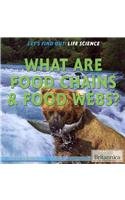-
Who Eats What?: Food Chains and Food Webs
Patricia Lauber
Library Binding (Demco Media, Jan. 1, 1995)Examines the significance of food chains and food webs, and explains why each link in a chain is important because of the interdependence of living things for survival
-
Food Chains: Who eats what?
Sam Hutchinson
Paperback (b small publishing, June 1, 2019)Plants photosynthesise sunshine into food, primary consumers eat the plants and secondary consumers eat the primary consumers. Nobody eats the apex predators at the top of the pile! And the decomposers break it all down... Trace the Sun's energy as it travels along food chains, through seven different ecosystems, sustaining life all over the planet. Beautiful cut-paper illustrations bring deserts, mountains and other habitats from around the world to life in style.
-
What Are Food Chains and Webs?
Bobbie Kalman, Jacqueline Langille
Audio CD (Crabtree Publishing Company, Oct. 1, 2008)Sunlight does not go very deep into water so seaweed must grow at the surface where its rays can reach them. Starting with the sun, food chains link together plants and animals in various ecosystems to help them survive. N
N
-
What Are Food Chains & Food Webs?
Louise Spilsbury
Paperback (Britannica Educational Pub, Jan. 1, 2014)This book explains the transfer of energy between living thingsknown as the food chainin a way that allows any reader to grasp the scientific principles behind food chains and food webs. The diets of herbivores, carnivores, and omnivores are explained, as well as other types of diets, and the flow of energy between these groups is made clear with arrowed diagrams and colorful pictures that show where different species derive their energy. Also examined are the effects different habitats have on the food chain, and how food chains in different environmental regions can be contrasted. U
U
-
What Are Food Chains and Food Webs?
Julia Vogel, Hazel Adams, Jacques Finlay
Library Binding (Magic Wagon, Sept. 1, 2010)"Food chains are fascinating! Did you know that all food starts with the sun? Plants use the sun's energy to grow, and then they become energy for animals. Every environment has factors that affect the flow of energy in its food chains--all the way up to you! Discover what plants and animals create the links of food chains and webs in each environment." -- p. 4 of cover. P
P
-
Food Chains and Webs
Abbie Dunne
Library Binding (Capstone Press, Aug. 1, 2016)Simple text and bright photographs explain the concept of food chains and webs for beginning readers. The book concludes with a simple, kid-friendly activity. M
M
-
Food Chains and Webs
Bray Jacobson
Library Binding (Gareth Stevens Publishing, Aug. 15, 2019)All organisms in an ecosystem are connected. Some are predator, some are prey, and others are just there to help decomposition. What's more, food chains and food webs are a crucial part of the Earth and life science curricula. Written for struggling upper elementary readers, the main content highlights the most important points, as well as the essential vocabulary relating to food chains and webs. Full-color diagrams aid readers' comprehension. Q
Q
-
What Are Food Chains and Webs?
Bobbie Kalman
Audio CD (Crabtree Publishing Company, Oct. 30, 2008)Sunlight does not go very deep into water so seaweed must grow at the surface where its rays can reach them. Starting with the sun, food chains link together plants and animals in various ecosystems to help them survive. N
N
-
Food Webs: Who Eats What?
Claire Llewellyn
Library Binding (Raintree, Jan. 1, 2014)This exciting book about the predator/prey relationship teaches readers about food webs. N
N
-
What Are Food Chains & Food Webs?
Louise A Spilsbury
Library Binding (Rosen Education Service, Jan. 1, 2014)This book explains the transfer of energy between living thingsknown as the food chainin a way that allows any reader to grasp the scientific principles behind food chains and food webs. The diets of herbivores, carnivores, and omnivores are explained, as well as other types of diets, and the flow of energy between these groups is made clear with arrowed diagrams and colorful pictures that show where different species derive their energy. Also examined are the effects different habitats have on the food chain, and how food chains in different environmental regions can be contrasted. U
U
-
Food Chains and Webs
Lewis K Parker
Library Binding (Perfection Learning, Dec. 1, 2005)Explore the food chains and webs in different environments. Find examples of producers, consumers, and decomposers. The balance of nature is what this book is all about. L
L
-
What are Food Chains and Webs?
By (author) Bobbie Kalman By (author) Jacqueline Langille
Paperback (Crabtree Publishing Co,Canada, Aug. 16, 1998)Excellent Book